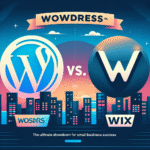In the digital age, having a strong online presence is essential for individuals and businesses alike. With a multitude of free website creators available, choosing the right platform can be daunting. This article will provide an in-depth comparison of the most popular free website builders, examining their features, usability, templates, SEO capabilities, and customer support to determine which one truly reigns supreme.
Overview of Free Website Creators
Free website builders are online tools that allow users to create websites without the need for coding or technical skills. They typically offer drag-and-drop interfaces and customizable templates, making it easy for anyone to build a site. The most prominent free website creators include:
- Wix
- Weebly
- WordPress.com
- Squarespace (trial version)
- Google Sites
Key Criteria for Comparison
To assess which website builder stands out, we will evaluate them based on several key criteria:
- User Interface and Ease of Use
- Design Flexibility and Templates
- SEO and Marketing Features
- E-commerce Capabilities
- Support and Community
- Storage and Bandwidth Limitations
- Monetization Options
1. User Interface and Ease of Use
Wix
Wix is celebrated for its intuitive drag-and-drop interface, allowing users to create a website from scratch with minimal effort. The Wix Editor is visually appealing and provides real-time editing, making it easy to see changes as they are made.
Weebly
Weebly also offers a user-friendly experience, with a simple drag-and-drop editor. It is slightly more structured than Wix, providing set sections to help guide users, which can be beneficial for beginners.
WordPress.com
WordPress.com has a steeper learning curve than Wix and Weebly. However, it offers greater control for users familiar with content management systems. Users can choose from a range of themes and customize them to suit their needs.
Squarespace
Although Squarespace is primarily known for its premium plans, the free trial version is aesthetically pleasing. The platform is designed with creatives in mind, but it can be less intuitive for beginners.
Google Sites
Google Sites offers a straightforward interface that appeals to users looking for basic functionality. However, it lacks advanced features and design customizations compared to its competitors.
2. Design Flexibility and Templates
Wix
Wix boasts a vast library of over 500 templates across various industries. Users can freely customize elements, arrange content, and add features, ensuring a unique design.
Weebly
Weebly provides a solid selection of responsive templates. While customization options exist, they can be somewhat limited compared to Wix, which may restrict creative freedom.
WordPress.com
WordPress.com offers numerous themes, with thousands more available through third-party developers. The design flexibility is unmatched, making it a preferred choice for those looking to create a highly customized site.
Squarespace
Known for its stunning templates that emphasize visual design, Squarespace stands out when it comes to aesthetics. However, its templates can be rigid, and users may find customization options limited.
Google Sites
Google Sites offers basic templates that are functional but lack the aesthetic appeal of other platforms. The design flexibility is restricted, catering primarily to users seeking simple, straightforward sites.
3. SEO and Marketing Features
Wix
Wix includes built-in SEO tools, enabling users to optimize their sites for search engines easily. Features such as SEO Wiz provide step-by-step guides for improving site visibility.
Weebly
Weebly comes equipped with essential SEO features that allow users to customize URLs, meta descriptions, and alt text for images. The platform also integrates with email marketing tools.
WordPress.com
WordPress is renowned for its SEO capabilities, offering a range of plugins (in premium versions) and built-in features. Users can optimize their content thoroughly, making it ideal for bloggers and businesses seeking organic traffic.
Squarespace
Squarespace includes solid SEO basics, but its capabilities may not be as extensive as WordPress.com. Users have the tools needed for SEO optimization, but the learning curve can be steep.
Google Sites
While Google Sites offers basic SEO features, it lacks the advanced options found in other builders, making it unsuitable for users prioritizing search engine visibility.
4. E-commerce Capabilities
Wix
Wix provides robust e-commerce functionality even on its free plan, though limited compared to premium options. Users can set up online stores, manage inventory, and process payments through various platforms.
Weebly
Weebly excels in e-commerce, providing users with advanced features for creating online stores. The free version allows basic e-commerce functionalities, but upgrading enhances capabilities significantly.
WordPress.com
E-commerce features are limited in the free version of WordPress.com. Users need to upgrade to the Business plan or higher for full access to WooCommerce, one of the most powerful e-commerce solutions.
Squarespace
Squarespace is a strong contender for e-commerce, with beautiful product displays and integrated payment options. However, this feature is only available in its premium plans.
Google Sites
Google Sites does not support e-commerce functionalities, making it unsuitable for users looking to sell products or services online.
5. Support and Community
Wix
Wix offers extensive customer support, including a dedicated help center with articles, tutorials, and customer forums. Live chat support is available, enhancing the user experience.
Weebly
Weebly provides various support options, including a knowledge base, community forums, and email support. However, live chat options may be limited depending on the plan.
WordPress.com
WordPress.com has a large community and extensive documentation available. However, direct support is limited for free users, with more premium support options available for paying customers.
Squarespace
Squarespace offers excellent customer support, including 24/7 live chat and email support. Their knowledge base is well-organized and informative, helping users troubleshoot effectively.
Google Sites
Google Sites has limited direct support, relying primarily on community forums and help articles. This can be a drawback for users needing immediate assistance.
6. Storage and Bandwidth Limitations
Wix
Wix provides 500 MB of storage and bandwidth on its free plan, which can be limiting for larger sites or those with extensive media content.
Weebly
Weebly’s free plan offers 500 MB of storage, with no specific bandwidth limit, though excessive traffic may prompt restrictions.
WordPress.com
The free version of WordPress.com includes 3 GB of storage, sufficient for small projects but potentially limiting for a blog or multimedia site.
Squarespace
Since Squarespace only offers a free trial, users must switch to a paid plan for storage and bandwidth information. Generally, their plans are more generous than those of free-only platforms.
Google Sites
Google Sites does not impose storage limits, but users cannot integrate third-party tools or services effectively, which can affect site capabilities.
7. Monetization Options
Wix
Wix users benefit from a wide array of monetization options, including running ads, affiliate marketing, and e-commerce. However, displaying ads from Wix is mandatory on the free plan.
Weebly
Weebly provides users with various monetization possibilities, including e-commerce and ad integration. However, ads from Weebly will appear on free plans, affecting user experience.
WordPress.com
WordPress.com allows users to monetize their sites using ads and affiliate links, yet full control over monetization requires a paid plan.
Squarespace
Squarespace’s monetization features are robust but primarily available in premium plans, making it less accessible for free users.
Google Sites
Google Sites does not offer any monetization features, making it unsuitable for users looking to generate revenue from their sites.
Conclusion: Which Website Creator Reigns Supreme?
When determining the best free website builder, the choice ultimately depends on individual needs and preferences.
- Wix is ideal for users seeking an intuitively designed platform with significant design flexibility and SEO features.
- Weebly excels in e-commerce capabilities, making it a great option for online stores.
- WordPress.com reigns supreme for content-driven websites and offers unparalleled SEO capabilities, although it has a steeper learning curve.
- Squarespace is unmatched in aesthetics but requires payment for advanced features.
- Google Sites is suitable for basic, no-frills websites but lacks essential features found in other platforms.
Given these insights, users should carefully consider their goals and requirements when selecting a website builder, as each offers unique strengths tailored to different online ventures.
[ad_2]If you’re exploring the world of free website builders and digital platforms, you might be intrigued by the evolution of user-friendly tools in web design. Speaking of user-friendly tools, you might be interested in the concept of a Content Management System, which provides the backbone for many website builders. Additionally, if search engine optimisation is a priority, you may want to delve into the principles of SEO to understand how to enhance your website’s visibility. For those interested in the commercial aspect, exploring the growing field of E-commerce could offer valuable insights into setting up online shops and monetising your digital presence. Each of these areas brings unique insights into building and managing an effective website.





